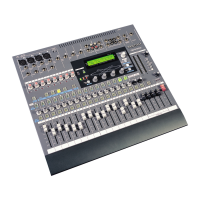
Do you have a question about the Tascam TM-D1000 and is the answer not in the manual?
| Brand | Tascam |
|---|---|
| Model | TM-D1000 |
| Category | Music Mixer |
| Language | English |
Highlights the digital mixing console's capabilities and features.
Provides guidance on preparing the TM-D1000 for operation and connection.
Describes the default settings for recording mode, including bus configuration.
Details the default settings for mixdown mode, including bus assignments.
Explains how to switch between recording and mixdown operational modes.
Outlines the different ways the four group/aux busses can be configured.
Details the routing paths of the busses to output connectors.
Guides connection of TDIF-1 digital audio devices for multitrack recording.
Explains how to set the word length for TDIF-1 digital audio interface.
Details how to connect stereo recorders to digital outputs.
Describes how to connect and route digital audio sources into the mixer.
Explains how to route digital effect unit returns as digital inputs.
Configures the TM-D1000 to provide the master word clock signal for a system.
Configures the TM-D1000 to receive its word clock from an external source.
Details how to adjust the equalizer settings for individual channels.
Explains how to assign input channels to group or aux busses.
Describes how to send channels directly to TDIF-1 outputs, bypassing busses.
Guides on using the built-in dynamic processors for channels.
Explains how to connect external processors using insert points.
Details how to link adjacent channels for synchronized control.
Explains how to select different sources for monitoring the audio signal.
Describes the different solo modes (PFL, AFL, IPS) for isolating channels.
Guides on choosing and applying different effect processing configurations.
Explains how to route aux busses to external effect units.
Details how to adjust the signal levels sent to auxiliary busses for effects.
Guides on choosing and activating specific internal effect units.
Explains how to fine-tune the settings of selected effects.
Details how to save custom effect settings for later recall.
Guides on saving the current mixer settings as a snapshot.
Explains how to load previously saved snapshot settings.
Details how to change the names of stored snapshots.
Explains how to synchronize physical controls with recalled snapshot data.
Describes a quick method to recall the first 16 user snapshots.
Guides on connecting the TM-D1000 for MIDI Machine Control.
Explains how to configure MMC Device IDs for communication.
Details how to use MIDI keys for transport control functions.
Explains how to arm tracks on connected devices using MIDI.
Describes storing and using location memories via MIDI Timecode.
Guides on choosing the correct MIDI Timecode (MTC) format.
Details how to save current timecode positions as location memories.
Explains how to jump to saved location memories.
Guides on modifying the timecode values of saved locations.
Configures which MIDI channels respond to Program Change messages.
Controls whether MIDI parameter changes are accepted.
Details how MIDI controller data can be recorded and edited.
Instructions for installing the TM-D1000 into a rack.
Information about the optional digital input expansion kit.
Details the optional effect board for expanded processing power.
Explains how to use a footswitch for control and operations.
Guides on adjusting meter display parameters like peak hold time.
Details how to adjust the display screen contrast.
Provides information on the internal backup batteries.
